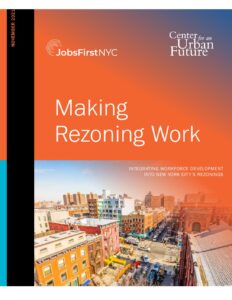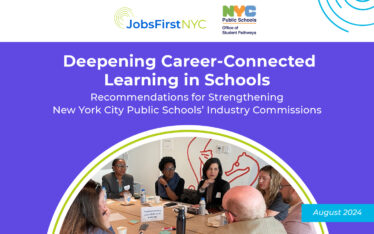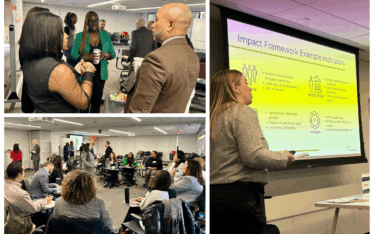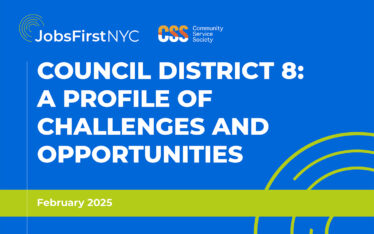As New York City grapples with a protracted economic crisis brought on by COVID-19, city leaders will be searching for opportunities to help spark a lasting economic rebound and regain many of the nearly 500,000 jobs lost since March 2020. One option is to use zoning tools to encourage economic development, attracting private investment at a time when public funding is extremely limited and helping to revive the city’s battered economy.
But to earn the trust of communities that have been hit hardest by the pandemic—and ensure that new development benefits the New Yorkers most in need of economic opportunities—New York City will need to develop a bold new vision for building workforce development infrastructure at the neighborhood level.
Since 2016, communities across New York City, from East New York to Inwood, have undergone large-scale residential rezoning. Designed to encourage the construction of affordable housing, neighborhood rezoning plans have nonetheless sparked understandable fears that new development enabled by land-use changes will lead to gentrification and displacement. The de Blasio administration has responded to these concerns by tying housing protections and other investments to neighborhood rezoning plans. However, thus far, the rezoning plans have lacked investment and accountability around local workforce development.
The need for these investments is clear: In the six neighborhoods which have already been rezoned, median household income is nearly $17,000 below the city average. More than a year into the COVID-19 pandemic, the estimated unemployment rate in East Harlem is upward of 20 percent and nearly 30 percent along Jerome Avenue in the Bronx. For many residents of these neighborhoods—and many others throughout the city—obtaining a living-wage job in an eventual economic recovery is made harder without access to quality workforce development services.
While recent rezoning plans have included numerous commitments—from housing protections for current renters to new community spaces and playgrounds—workforce investments have been minimal. According to its commitment trackers, the city budgeted just $462,250 for job training initiatives focused on just two of the six residential neighborhoods approved for rezoning since 2016. Just $312,500 had been spent on new job training programs as of June 2021.
A more deliberate approach is needed: one that provides communities with a blueprint for establishing and strengthening neighborhood-level workforce networks, taps private sector dollars to invest in meeting workforce needs, builds the capacity of training providers to serve more residents, scales up the most effective workforce programs from across the city, and incentivizes partnership and collaboration. This report examines the current role of workforce investments in the city’s recent and ongoing neighborhood rezoning plans and charts a path for city policymakers, workforce practitioners, philanthropic leaders, and local community-based organizations and business leaders to support a new model for place-based workforce investment that can help expand economic opportunity in the communities that need it most.
This report—a joint effort between the Center for an Urban Future and JobsFirstNYC—demonstrates the need to integrate a comprehensive workforce development strategy into future rezonings and offers a blueprint for how to do so. Informed by more than 50 interviews with workforce development practitioners, community leaders, city officials, nonprofit executives, and economic development experts—as well as analysis of data on economic and workforce conditions, city reports, budget documents, and other information—the report identifies effective models for place-based workforce development in and outside New York, examines obstacles to integrating workforce development investments into rezoning plans, and lays out a set of practical and actionable recommendations to integrate community-focused skills-building and workforce development investments into rezoning efforts—now and in the future.
The report outlines seven recommendations that the next mayor should enable in order to make coordinated workforce investments a top priority.
- Launch a comprehensive neighborhood-based workforce development strategy to build and strengthen local hiring and training networks and coordinate investments across agencies.
- Develop a local workforce network in every neighborhood with a poverty or unemployment rate higher than the city average—whether or not a rezoning is imminent.
- Establish citywide linkage fees for developers of market-rate commercial, residential, and industrial space, and use the proceeds to create an education and training fund for neighborhoods undergoing rezoning.
- Require developers and contractors with city contracts to partner with local workforce networks and pass community hiring legislation at the state level
- Leverage public funding to incentivize long-term partnerships among community-based organizations and workforce development providers.
- Create a community toolkit for designing and planning workforce investments as part of any future zoning reform.
- Set a goal of launching 5,000 new apprentices by 2025.





